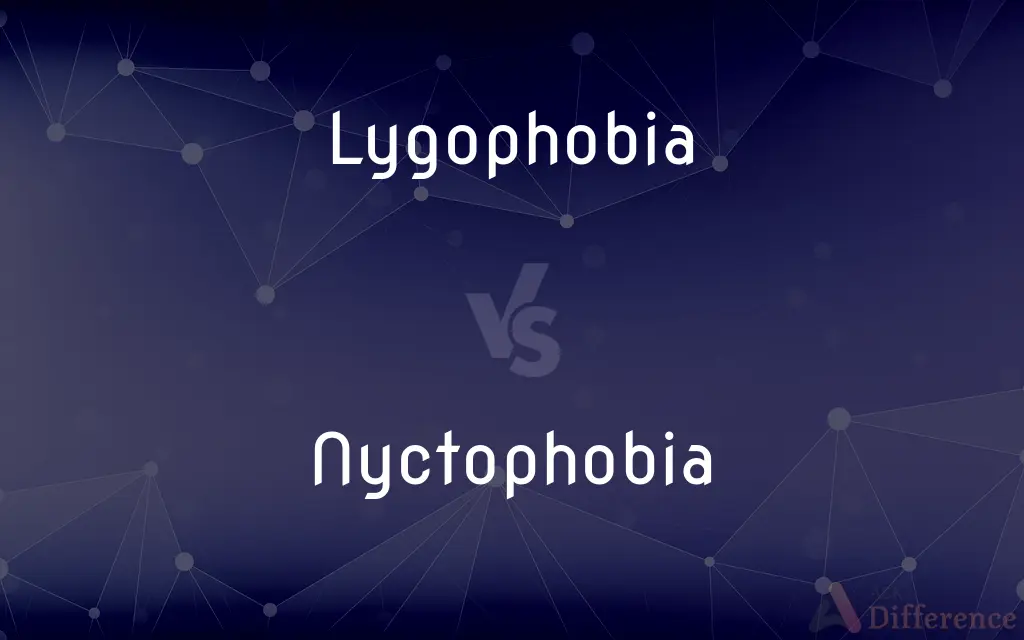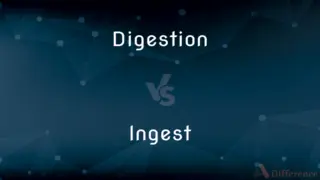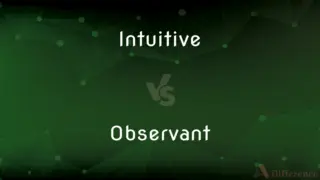Lygophobia vs. Nyctophobia — What's the Difference?
By Maham Liaqat & Fiza Rafique — Updated on April 2, 2024
Lygophobia focuses on an intense fear of darkness itself, often tied to the unknown, while nyctophobia is a broader fear of the night and its associated conditions.

Difference Between Lygophobia and Nyctophobia
Table of Contents
ADVERTISEMENT
Key Differences
Lygophobia manifests as a debilitating fear specifically of darkness, rooted in the anxiety caused by its association with the unknown or potential threats hidden within it. On the other hand, nyctophobia encompasses a broader spectrum of fear, not just limited to the darkness, but also including the night time and everything it represents, from the isolation to the quiet.
Individuals with lygophobia may experience intense anxiety in any dark environment, regardless of the time of day, due to the lack of visual stimuli, which their mind may associate with danger. Whereas, those with nyctophobia might feel anxious during the night, regardless of whether they are in a well-lit area or not, as their fear is more closely associated with the concept of night itself.
Treatment for lygophobia often involves exposure therapy, where the individual is gradually and repeatedly exposed to darkness in a controlled and supportive environment, aiming to reduce their fear over time. In contrast, treatment for nyctophobia might include not only exposure therapy but also cognitive-behavioral therapy (CBT) to address the broader anxieties related to the night.
People with lygophobia might find some relief by using nightlights or keeping a small source of light nearby, as their primary issue is with the absence of light. On the other hand, individuals with nyctophobia might require more comprehensive strategies, such as sleep hygiene practices or therapy, to feel safe at night, regardless of the presence of light.
While lygophobia is specifically about the fear of darkness, implying a more focused area of fear, nyctophobia's tie to the night encompasses a wider range of fears, including but not limited to darkness, making it potentially more complex to address.
ADVERTISEMENT
Comparison Chart
Definition
Fear of darkness, often due to its association with the unknown.
Fear of the night, including darkness and its perceived threats.
Trigger
Absence of light regardless of time.
Presence of night, not solely dependent on the absence of light.
Symptoms
Anxiety in dark environments, possibly leading to avoidance.
Anxiety at night, which may include being in well-lit places.
Treatment Approaches
Exposure therapy to darkness.
Exposure therapy to night settings, CBT for broader anxieties.
Coping Mechanisms
Use of nightlights, keeping some form of light accessible.
Comprehensive strategies including sleep hygiene, therapy.
Compare with Definitions
Lygophobia
Often associated with the fear of unknown dangers hidden in the dark.
Lygophobia isn't just about the lack of light but what might be lurking unseen.
Nyctophobia
Strategies for coping include sleep hygiene.
Improving sleep hygiene has helped him manage his nyctophobia.
Lygophobia
Can be managed with gradual exposure to darkness.
Therapy for her lygophobia involves spending short periods in a dark room.
Nyctophobia
Nighttime anxiety not limited to darkness.
Even in a lit room, her nyctophobia can be overwhelming.
Lygophobia
Anxiety triggered by the absence of light.
His lygophobia makes nighttime very stressful.
Nyctophobia
Fear of the night and its encompassing conditions.
Her nyctophobia makes her dread sunset every day.
Lygophobia
Intense fear of darkness.
She avoids unlit rooms due to her lygophobia.
Nyctophobia
Treatment may involve cognitive-behavioral therapy.
She's undergoing CBT to help with her nyctophobia.
Lygophobia
May require constant access to a light source for comfort.
Due to his lygophobia, he always carries a flashlight.
Nyctophobia
Can include fear of being alone in the dark.
Nyctophobia often means he can't be by himself at night.
Lygophobia
(rare) Fear of darkness.
Nyctophobia
Excessive fear of the night or darkness. Also called scotophobia.
Nyctophobia
A fear of the night, nighttime, or darkness.
Nyctophobia
A morbid fear of night or darkness
Common Curiosities
How do you treat lygophobia?
Treatment often involves exposure therapy, gradually acclimatizing the individual to darkness in a safe environment.
What is lygophobia?
Lygophobia is the fear of darkness, often linked to the anxiety over what cannot be seen or the unknown dangers it might hide.
Does nyctophobia only occur at night?
While it is primarily related to the night, individuals with nyctophobia may also experience anxiety in anticipation of the night or in dark places during the day.
Can children outgrow nyctophobia?
Yes, many children outgrow nyctophobia as they get older and their understanding of the night and darkness evolves.
What are the symptoms of nyctophobia?
Symptoms include excessive anxiety at night, possibly even in well-lit areas, trouble sleeping, and avoidance of night-time activities.
What coping strategies are effective for lygophobia?
Strategies include using nightlights, gradual exposure to darkness, and seeking professional therapy.
How can someone with lygophobia cope during power outages?
Keeping battery-operated lights or flashlights readily accessible can provide comfort and help manage anxiety during power outages.
What causes nyctophobia?
Nyctophobia can be caused by a variety of factors, including past traumatic experiences during the night, or it may be a symptom of broader anxiety disorders.
Are lygophobia and nyctophobia the same?
While they are related, they are not the same. Lygophobia is specifically a fear of darkness, whereas nyctophobia is a fear of the night, which may include but is not limited to darkness.
Can adults develop nyctophobia?
Yes, while it's more common in children, adults can develop nyctophobia, especially following traumatic events or due to underlying anxiety disorders.
Can lygophobia affect sleep?
Yes, individuals with lygophobia may have difficulty sleeping in the dark, leading to disrupted sleep patterns.
How does exposure therapy work for lygophobia?
It involves gradually increasing exposure to darkness while practicing relaxation techniques, aiming to desensitize the individual to their fear.
Is lygophobia common?
Yes, it is a common phobia, especially among children, though many adults also experience it.
Is there medication for treating nyctophobia?
While medication is not a primary treatment, it may be prescribed to manage anxiety symptoms associated with nyctophobia.
How can nyctophobia impact daily life?
It can lead to avoidance of going out at night, disrupted sleep patterns, and significant anxiety as nighttime approaches.
Share Your Discovery

Previous Comparison
Digestion vs. Ingest
Next Comparison
Intuitive vs. ObservantAuthor Spotlight
Written by
Maham LiaqatCo-written by
Fiza RafiqueFiza Rafique is a skilled content writer at AskDifference.com, where she meticulously refines and enhances written pieces. Drawing from her vast editorial expertise, Fiza ensures clarity, accuracy, and precision in every article. Passionate about language, she continually seeks to elevate the quality of content for readers worldwide.














































